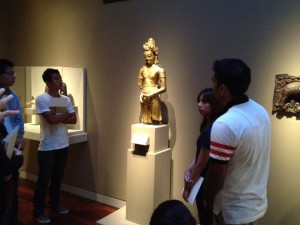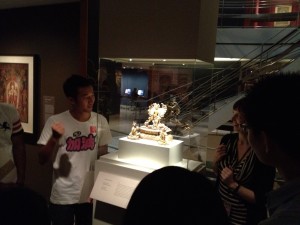Marcos and I welcomed twelve Baruch College students to the museum in mid-August to attend an orientation and training program. The students had been selected by the college to serve as Peer Mentors for the upcoming 2012-13 academic year. These coveted paid positions provide upperclassmen the opportunity to learn leadership skills while serving as mentors once a week for incoming Freshmen. One of their duties this Fall will be to bring groups of Freshmen during their weekly activities hour to the museum for 30-minute gallery visits.
To help the mentors get a feeling for the history of the museum, we began with an introduction at the base of the spiral staircase. The students enjoyed hearing how Donald Rubin, the museum’s founder, once stood in the same place about eight years ago and felt a heart connection with the space and envisioned a museum to dedicated to Himalayan Asian art. The first thing he did was call his wife, Shelley, to share the happy news.
Once in the galleries, Marcos facilitated a lively group discussion using an innovative teaching technique, VTS (Visual Thinking Strategies). Deceptively simple, VTS relies on a facilitator asking three simple questions that can illicit deep and complex responses from groups while looking at works of art. To learn more about how VTS is used by museum educators, check out Marcos’s blog, Visual Thinking Strategies and the Rubin Museum, July 24, 2012.
 This sculpture of a bodhisattva is a favorite among college students. At a distance, it radiates a sense of tranquility and inner peace, exemplified by the graceful pose and downcast eyes. On closer inspection, however, one discovers that the piece is badly damaged, limbs are severed, the nose is chopped off, and the chest is riddled with holes, perhaps from bullets. According to Buddhists, a bodhisattva not only defers his/her own enlightenment, but takes on the suffering of the world out of compassion for all sentient beings. With the understanding that the piece both embodies suffering and illustrates its transcendence, students often feel compelled to share their own stories of suffering, survival, and transcendence.
This sculpture of a bodhisattva is a favorite among college students. At a distance, it radiates a sense of tranquility and inner peace, exemplified by the graceful pose and downcast eyes. On closer inspection, however, one discovers that the piece is badly damaged, limbs are severed, the nose is chopped off, and the chest is riddled with holes, perhaps from bullets. According to Buddhists, a bodhisattva not only defers his/her own enlightenment, but takes on the suffering of the world out of compassion for all sentient beings. With the understanding that the piece both embodies suffering and illustrates its transcendence, students often feel compelled to share their own stories of suffering, survival, and transcendence.
 When students first see Durga and learn this beautiful female Hindu deity not only defeated the most powerful demon in the universe, Mahishasura, but defeated the demon in style–with a gorgeous hairstyle, jewelry, and sixteen her arms whirling round her head–a hush falls over the group. One student broke the silence by commenting, “She reminds me of Lara Croft but with more arms and weapons…that’s my kind of super-hero.”
When students first see Durga and learn this beautiful female Hindu deity not only defeated the most powerful demon in the universe, Mahishasura, but defeated the demon in style–with a gorgeous hairstyle, jewelry, and sixteen her arms whirling round her head–a hush falls over the group. One student broke the silence by commenting, “She reminds me of Lara Croft but with more arms and weapons…that’s my kind of super-hero.”





